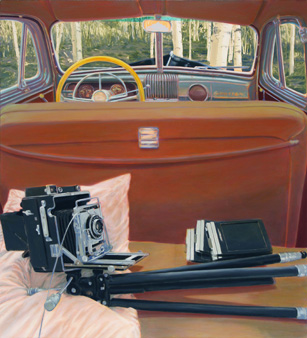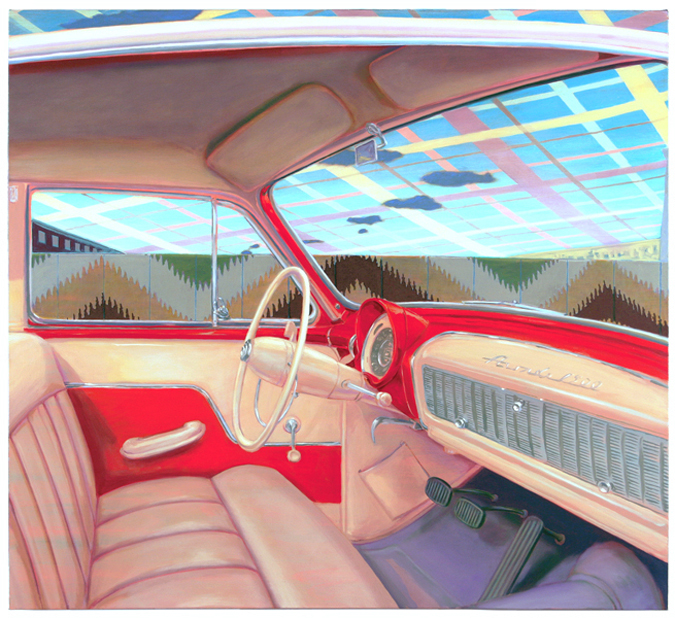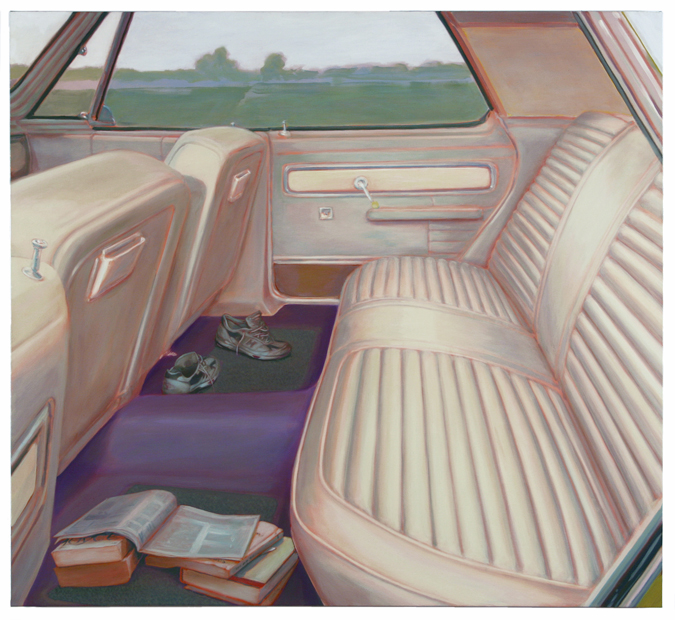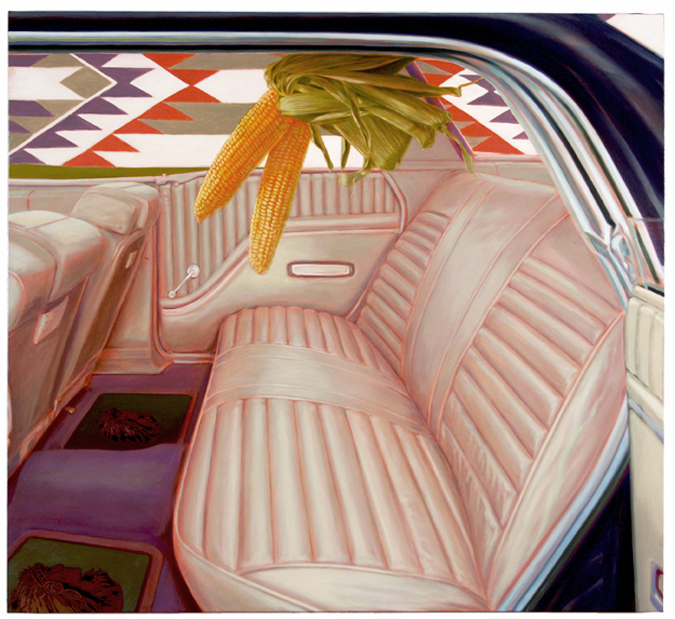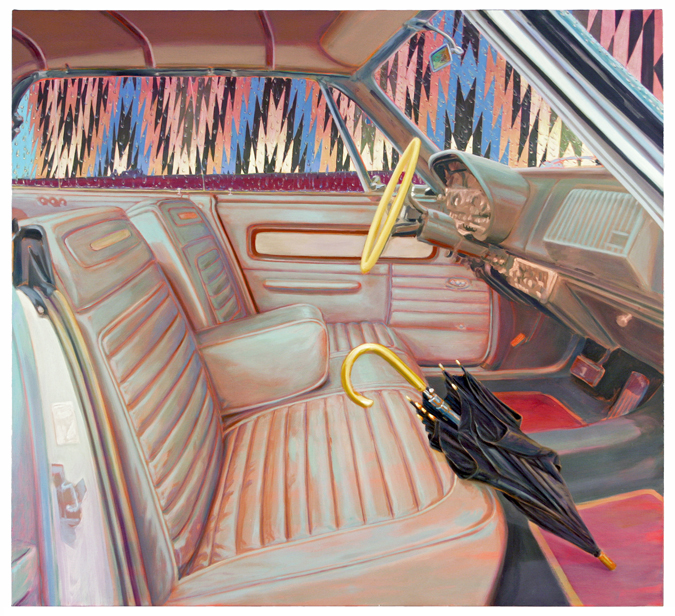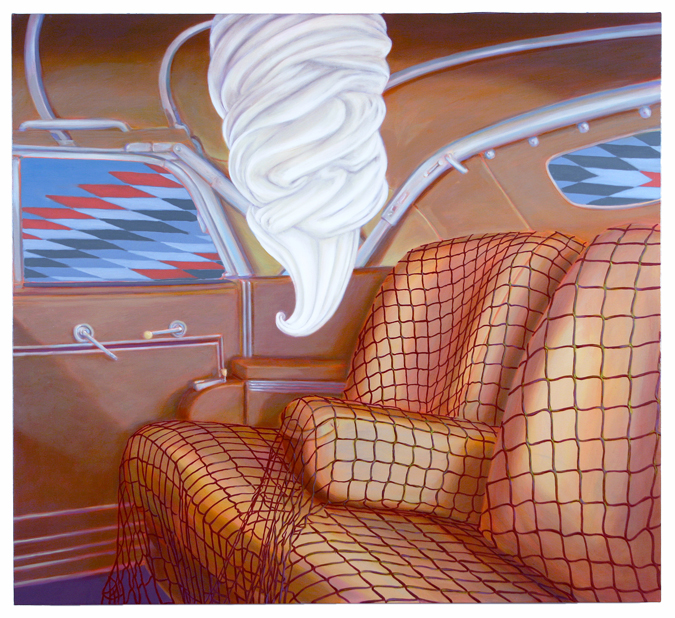Interview with Greg Drasler
FRAGMENTS OF AN INTERVIEW with GREG DRASLER by Romanov Grave
To begin: A painterly fusion cuisine
A kind of visual hyperbole
Arresting
Variegated, tectonic shifts of inside/outside, kaleidoscopic, prismatic
Continuing my interests with containment and projection, I recollect myself in the auto interior. I began these paintings with thoughts of elliptical movement and return. Images of vehicles merged with ideas about painting as dynamic containers aimed for elsewhere. A slingshot effect of close description tethered to a patterned landscape set up a situation that is at once domestic and alienating. I am attracted to this back and forth inducement to drive and ride a painting. Combinations of categories, allusions and effects found a place in the automobile/automatic interior. A hyperbolic anywhere with destinations unknown, a drive-in, drive-by or drive-away. The image of the vehicle shadows painting as metaphor.
Here an upholstered armchair and love seat on wheels clings to domestic benefits but is explicitly designed to accommodate drives. The steering wheel ellipses indicate control in a side long view of possibly getting somewhere else. In wide transit around assorted dialogical batteries, these auto interiors are parked as reveries of places and things. These moments in “going there” prefer the transition, process and itinerary over a destination.
Smoke Signals 2011 oil on linen 40×44 inches
Sojourning, America on the move. “Wise Blood,” “Grapes of Wrath,” the frontier
Pattern recognition
Impossible convergences
“Going places,” “hitting the road” and “Where do I think I’m going?” were regular voice-overs of restlessness, anxiety and animation that accompanied the making of these paintings. The American pastime and an America past time collude to expand the road trip into a right of passage mixed with a salvage operation. A lyric sensibility occupies these paintings. Patterns of movement, travel and displacement are a folklore in an America on the move and in the movies.
The built-in expandability of patterns implies a reach similar to a landscape. A pattern inspires two ways of looking. Both imply scanning. First, being in pattern, provides a predictable formula. Being in pattern allows one to be absorbed. The second activity is the search for an anomaly as a limit to the patterns projection. On the most basic level a hand painted pattern is rife with this evidence of the irregular out-of-the-norm occurrence if only as the evidence of a heartbeat in a painting hand.
Machine learning, the site search procedures of algorithms combined with free association, deliver irregular and familiar findings of correspondence within the picture. Pictures allow the containment of variances, abnormalities and idiosyncrasies, built on accidents and intuition to occupy places as coincident meetings. Scanning through patterns and driving through a landscape, transmits a montage of passing effects collected as a vehicles product.
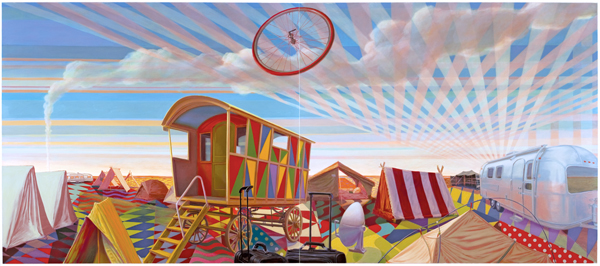 On the Lam, 2011, oil on linen, 70 x 160 inches
On the Lam, 2011, oil on linen, 70 x 160 inches
A high-altitude outpost of painting, vivid, bordering on lurid, rather than hyper-real.
Cars—American symbol for social mobility—Lolita’s motels to Kerouac—symbols of both affluence and indigence
Sociological commentary is glancing in Drasler’s work, which is instead cinematic.
I inscribe pictures with a capacity for restlessness that mixes up continuity. Self searching GPS technology imbedded in an period vehicle, as an amalgamated here-and-now, then-and-there with a pestering of where-and-when conjures the expression “Together again for the first time.” Through repositioning, retro-fitting and recycling I resolve the familiar with the glancing double takes of parallel play and second endings. A vehicle that composes and restructures as it rolls along is the mode of painting that I embrace. In a painting built and driven to contain the accumulation of transient references, I become a passenger and occasionally a back-seat driver as I work. My voice-over whether as a subtitle or a dubbed image in production, offers a lyric to making like whistling in the wind. Juggling several contexts at once, I trace a fast-cut edit and shuffle. Collisions are inevitable. Beginning a painting on a whim and often finishing it as a devotional image, I maintain attention to the displacements of representation.
Notions of privacy and license, vernacular and spectacular are internal combustibles that generate locomotion. Beyond utility, a vehicle is a mechanism for wanderlust and disaffection. It becomes the eye of the needle with which we embroider ourselves into and across the landscape. An apparatus that comes with built-in drives also provides a place of ones own on wheels.
The view through the auto window frames an overtly constructed landscape conserving the place of the subject inside. The depiction of vehicles with pronounced interior capacities for motion and drive mimic the condition of painting as a moveble site. When I imagine a car, I think about it from the inside looking out. Facing a painting I address the image as a collection of fragmented thoughts and feelings as they hit the windshield. As time accumulates in painting, close description, juxtaposition and incidence come together in a grounding effect. The sum is an emulsion of processes, the language and architecture of pictures.
I think about the car as a camera – and painting as a vehicle.
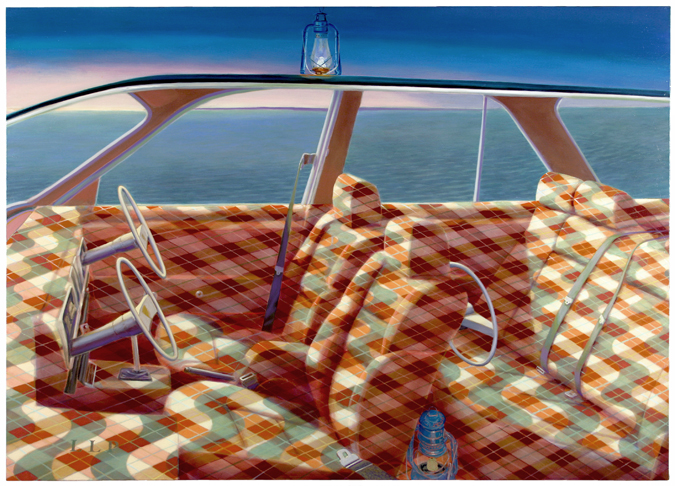 Mergers and Acquisitions 2011 oil on linen 50×70 inches
Mergers and Acquisitions 2011 oil on linen 50×70 inches
Drasler’s “wheels” have no eschatological ambitions, no destination. They seem instead to float. Even when clearly “parked,” as in On the Lam, in which camping tents and airstream trailers mingle with gypsy caravans on a kilim of a field—even there a spoked wheel has flown off and up into the Technicolor sunrise or sunset. The skies are the most riveting part of these new paintings. They have the gorgeousness of those sunsets that DeLillo’s characters run to view as spectacle, but without alluding to environmental pollution. They are not ominous so much as fantastic, along the lines of the Wizard of Oz. And very powerfully connected to the folk art of the Midwest, especially to patchwork quilts. Disassembled or illogically bricolaged, Drasler’s vehicles cease to be vehicles.
Paintings made of parts joined are darned confections. The modest idealism of pieced quilts, outsider art and carpenter construction follows expectations of starting out as a Western but ending up somewhere in the middle. The Midwestern effect is heightened through my elliptical return: a familiar mending of things through the piece-work stitching of ideas and allusions. On the edge of town would be the circuit and location for On the Lam. A condition of floating or displaced objects in or under a big sky over corn and soy bean fields with stud frame construction on the edge of town reveals itself in dawn light. The extendibility of space is contrasted with place as a grounding, an isolation. The weave and weft of the landscape grips the projected aim of mobility. Wanderlust takes the wheel, hits the road but spins out into the panoramic double wide environment of On the Lam.
Nudist 2011 oil on linen 40×44 inches
Period cars rendered cinemascopically wide.
Often stretched-open a little wider as in a dental exam, the familiar place of the auto-interior takes on consuming implications. In automobiles used in comedies, romances or dramas – from the hand-held contemporary camera to the rear projection of studio production – the place of the auto interior is location-variable opportunity. The apparatus of film production in its departmentalization and collaboration allows for full employment of a compound self in the drive to make pictures. Period cars shuffled and tossed with jovial disregard for continuity, point to a larger implication: that of a costume drama – all periods at once. What I look through and what I look around adds a temporal element to how I see.
I think of the moving car as a cinema.
Idol Idle Idyll 2011 oil on linen 40×44 inches
And, though full of symbolic possibilities, it might be fair to say that the paintings themselves similarly have no agenda, no point to make. They ask only to pleasure themselves and their audience.
Being along for the ride has such an ambivalent undertone. But when I think about it, that is what I want in a vehicle, a driver and the knowledge that it is mine to drive anywhere. Yes there is symbolism but at the center it is empty – a garment on the rack with plenty of attitude and detailing but destination unknown. I try to maintain this capacity for the passenger while I take a ride. Abandoned auto interiors or camping structures provide contrast to the dominating reach of the structured atmospheres. The skies are intentionally assembled to be more object than subject, relating the atmosphere of the picture to a handyman’s-special.
There is an erotic charge to close descriptions. Pulling over to park, getting a closer look or finding a place for the night provides a situation in which I can linger in the light, texture and temperature of a painting. The attachment of symbols slows down time as I paint; hitting heavy traffic. Through this pile up of time I consider my paintings written in longhand. Their locality is a collusion of the blurred seams of here and there. Here is one pile-up of allusions: the exegesis of interior detailing in upholstery and window cranks, the effect of aniline dyes on Native American weaving, and the history of road-side attractions. These are events along the way, eclipsing the destinations of meaning.
Rain Dance 2011 oil on linen 40×44 inches
A vanished America
Where the speed is too fast to loiter on what is behind, the rear view mirror becomes a sign of reflection in motion. There is a lot of static. My long-standing interest in place as a nexus for where one is, sobers me when asked about such a broad subject as America. Perhaps a late model Trojan House on wheels encapsulates how the unbounded variability of the local has been swallowed into the interior for a subject’s drives. Through the possible multiples, residuals and knockoffs of every moment we perceive, shelf life is the new currency. A reverb effect of repetitions and rhymes of experience presents an echo of something else as a reassurance. The refrain “How can I miss you if you don’t go away-” comes to mind. What has vanished is not far away as objects are closer than they appear in the rear view mirror.
Vernacular continues to fascinate through its creative relocation of commonalities and expressions, expanding the band width of everyday speech. The discarded, outmoded and obsolete inspire the prospector in me. When does a dangling modifier become a double meaning?
Palette and style: realistic but never to be mistaken for real. Hard-edged but with cast shadows and highlights, never any scumbling, no blurring, high key colors. As if Phillip Pearlstein and Roger Brown had conceived a child or as if Pattern and Decoration painting had married illustration. This may sound reactionary but is possibly a new option for painting, a radical ambivalence.
A crazy quilt accumulation of symbolism and structure maps a prospector’s ambivalence; at once significant but assembled from here and there. My attractions to a long list of artists is continually in play. Introduction to the works of Jim Nutt, H.C. Westerman and Roger Brown occurred along with seeing James Rosenquist’s F-111 in Chicago in the mid 60’s. It left an indelible imprint on me. I was 16 and had just earned my drivers license and was able to drive into Chicago to look at art. Working between influences engages me in reconnoitering, hybridizing and blending as a latter-day Gregor Mendel.
Speculative paternity is a great source of romantic fiction and an expression of aspiration for a rightful heir. My signaling for recognition and acknowledgement in sourcing influences and gene pool contributions to my work is potentially so wide that I feel orphaned at times. My gathering of influences is directed at constructing accords between contrary attractions.
Painted things inevitably include evidence of sublimated intentions. I hold this elliptical condition of representing as a two-way mirror.
In a Twist 2011 oil on linen 40×44 inches
Painting for Drasler becomes a sort of delta, a collection point for the silt of different, variegated content. The fragmentary nature of the work is more interested in creating a whole out of scraps—again like quilting—rather than creating disjunctions to make an argument about discontinuity, a la the Leipsig school. There is a coherent point of view here, a renaissance space. The incongruities still fit together, like a jigsaw puzzle, even if the overall picture remains puzzling.
I think of painting as a site; a site with a past too wide and deep to be fully grasped and potential possibilities providing conditional models for freedom. I like the term delta but for me a painting works like a suitcase. Variously packed, it accommodates the drives, preparations, changes, connections and buildups to a trip. In a container, the order of how things fit and the incongruities of breaking patterns have a place in which to meet and work it out. This is the slow tight traffic of painting for me. My drive to deliver these effects within an apparatus of a picture, complicates looking with reflecting. Looking at a painting is akin to slipping into the place left by the painter. It is inevitably local and I agree, puzzling.
The color is lurid, the heft is featherweight, with all that floating and disembodiment, the texture is plastic or cellophane-wrapped. Both mainstream and deviant. What is the opposite of an iconoclast? An iconophile? It is as if Drasler more than concedes the impasse of representation; he feels it in his bones. Yet he cannot disburden himself of his love for the painted image, for illusion’s effects.
The weaving of disjunctions, displacements and anomalies prepares for allusions, symbols, signs and vanities of ideas as half cornucopia and half Trojan horse. Being a mainstream deviant iconophile seems to carry a fascinating and attractive crosscut status. Through what I notice and follow, the many leads and notions I peruse makes work move like a procedural. The plastic ability of paint to describe texture and sheen of material brings the pyrotechnics of light into the mix. Color is a strange attractor similar to a cuisine. Beyond the shadow and light, the astringent, sweet, salty or rich flavor of light depicted by color, invites appetite. Dimension and atmosphere provide an opportunity to paint the temporal effects of thinking through its spatial consequence; giving point of entry. This is my way of connecting with a basic embrace of painting.
My paintings are abstract. They depict many things to grab and hold on to but remind me of Heisenberg’s Uncertainty Principal translated into illusion. Look for a subject and an object appears. Look for an object and it defers to being more of a subject. My pictures are aimed at gathering together the traces, additions, displacements and locations into a lyric of my own.
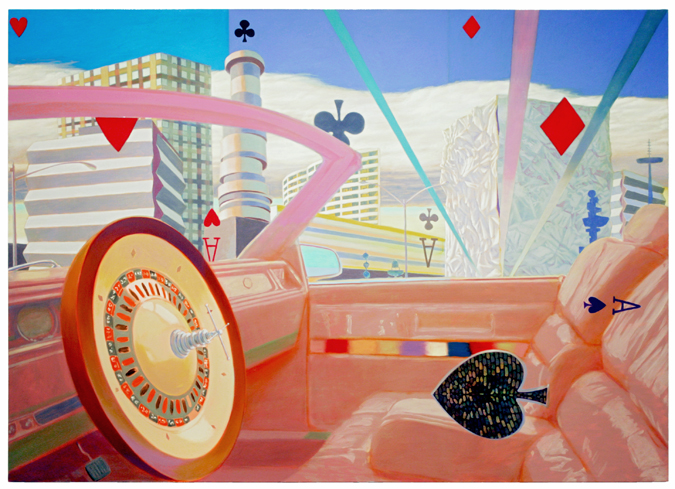 Top Down 2011 oil on linen 50×70 inches
Top Down 2011 oil on linen 50×70 inches
He glorifies partition but balks at decomposition. The very compartmentalization while emphasizing incompatibility and refusing complete coherence also refuses entropy, slippage, slurry.
I approach the familiar. Driving into it, through it and around it building a locality and a terrain of references that I strive to bring forward into a plausible present. My intention is to play it through, to lead one in and to slip out. I continue working between containment and projection. This is the synoptic plot of my occupation. Images, genuine and imagined, inspire pictures that lead me to painting. It is a suspended animation of my thinking.
Exhibition: Greg Drasler – On the Lam , Betty Cuningham Gallery, New York, NY September 8 – October 15, 2011
